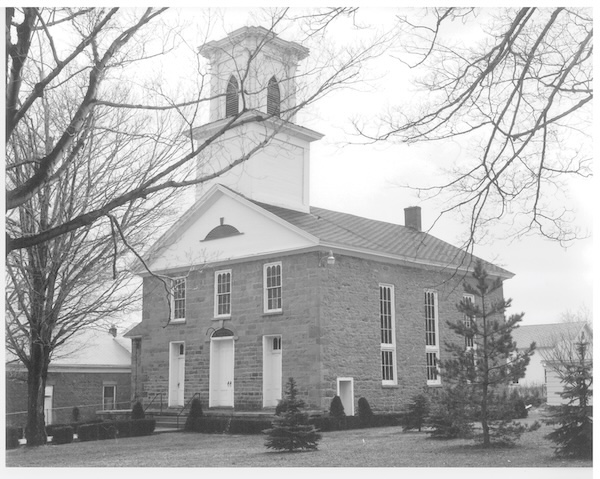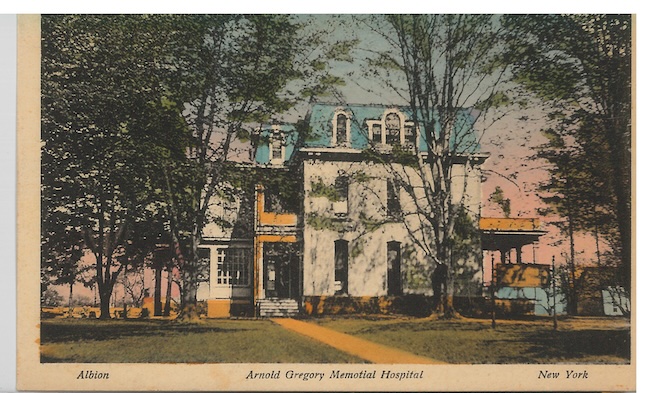Historian’s book on architecture destroyed in Orleans County gets an update
By Ginny Kropf and Tom Rivers

This is the cover of “Architecture Destroyed in Orleans County, New York,” a book first written by C.W. “Bill” Lattin in 1984. The cover shows E. Kirke Hart residence in Albion that was demolished in 1942.
ALBION – A book that was published 40 years ago highlighting mansions, churches and prominent buildings in Orleans County that were lost to fire or the wrecking ball has been updated.
C.W. “Bill” Lattin reprinted the book “Architecture Destroyed in Orleans County, N.Y.” It includes more structures that have taken down, including the Clarendon Universalist Church in 2006. That church was built in 1837.
A cobblestone smokehouse from about 1840 at the Five Corners in Gaines also was removed in 2022.
Proceeds from the reprinting of the book go to Cobblestone Society and Museum. The books are available for $15.
Doug Farley, the museum’s director, said Lattin’s book is a valuable resource of historic text and photographs.
“Orleans County, and in particular Albion and Medina, have had a treasure trove of beautiful buildings,” Lattin writes in the book, when it was first published in 1984. “It is indeed very unfortunate that some of the best examples of certain architectural styles were wrecked in the name of so-called ‘progress.’ The reader will quickly ascertain that some very fine buildings were demolished over 100 years ago. But unfortunately, many marvelous architectural creations have been destroyed in recent years, too.”
As a result, Lattin has added more up-to-date content to this printing to supplement what he originally wrote in 1984.
One of the features of the original publication was a list of more than 200 patrons and business sponsors who contributed toward the cost. These names are included in the reprint, as well as more than 60 new sponsors for 2024.
“These history-minded contributors have had their names printed in the new publication and are welcome to pick up a complimentary copy now at the Cobblestone Museum,” Farley said.
In his introduction to the latest book, Lattin says he has been fascinated with old buildings as far back as he can remember, even as a small child. He says a lot of very fine buildings were wrecked more than 100 years ago, but the worst toll has been since World War II.
One structure was a rustic log cabin on the Peter Smith Road, the last legitimate log house of its type in the county when it was torn down in the 1950s. Also demolished were many churches, such as Presbyterian churches in Holley, built in 1831, and the Presbyterian Church in Knowlesville, built in 1832.
Schools, such as the Yates Academy, the cobblestone Loveland School House in District #6, Albion, and Oak Orchard Elementary School in Medina were not spared the wrecking ball.

This photo credited to Alan Isselhard is the Clarendon Universalist Church which existed from 1837 to 2006. The federal style building was built of limestone which was quarried locally.
Many other notable structures met their fate, including a blacksmith shop in Millville, mills, the Orleans County Infirmary, hotels and elegant mansions, notably the home of Arnold Gregory on County House Road.
“By compiling this book, I want people to know and see what a truly beautiful village Albion once was,” Lattin said. “And I want people to see some of our other marvelous architectural creations which once stood throughout Orleans County.”
He added there is at least one destroyed building from every township in the county included in his book.
When he decided to put together a book, he said it seemed most appropriate to have the Cobblestone Society, as the leading preservationist group in Orleans County, publish it. The Society, which has preserved 10 buildings of its own, was founded for the purpose of preserving not only cobblestone structures, but related art and architecture.
A grant from Genesee-Orleans Regional Arts Council (GO Art!) helped pay for the reprinting.
Erin Anheier, a former Cobblestone Museum president and a current trustee for the Landmark Society of Western New York, said Lattin’s book should inspire the community to appreciate and save the “wonderful old buildings” that remain in Orleans County.
Many of the sites are no longer used for their original purpose, but could be preserved and adapted for different uses, Anheier writes in the book’s epilogue.
“The variety of the architectural styles of past decades enlivens our landscape and speaks of the lives and hopes of our ancestors,” she said. “I would not want to live in a place that didn’t show its unique history with pride. A cookie-cutter community holds no appeal.”




































































